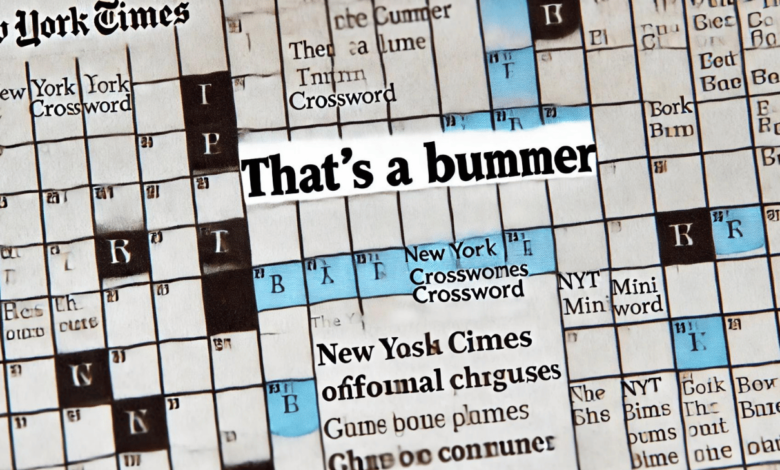Thats a Bummer Nyt: A Phrase with Impact in the World of Crossword Puzzles

Crossword puzzles have always been a favorite hobby for millions around the globe, with The New York Times (NYT) crossword standing as one of the most prestigious and well-regarded. Among the myriad clues that have puzzled and delighted solvers, the phrase Thats a Bummer has made its mark. This seemingly simple phrase has gained attention, particularly in the NYT Mini Crossword, where it was featured as a clue, sparking discussions among puzzle enthusiasts.
In this article, we’ll explore the significance of the phrase Thats a Bummer, its use in crossword puzzles, particularly in the New York Times, and its broader cultural implications. We’ll also delve into the nuances of crossword puzzles as a linguistic art form, how clues are crafted, and why specific phrases like this resonate with creators and solvers.
The Origin and Meaning of Thats a Bummer
Thats a Bummer is a colloquial expression commonly used in everyday English to express disappointment, sympathy, or mild frustration. The word “bummer” itself is believed to have originated in the mid-20th century, possibly deriving from the German word “bummler,” meaning a loafer or idler. Over time, it evolved into a slang term in American English, conveying a sense of something unfortunate or disappointing.
This phrase is versatile and often used in casual conversations when reacting to news or situations that are less than ideal. For instance, if someone missed an important event due to unforeseen circumstances, a friend might respond with, Thats a Bummer, acknowledging the disappointment while maintaining a light, conversational tone.
The Crossword Puzzle Connection
The New York Times crossword puzzle, known for its challenging and clever clues, occasionally incorporates phrases from everyday language, making them accessible yet thought-provoking. On May 23, 2024, the phrase Thats a Bummer appeared as a clue in the NYT Mini Crossword. The answer to this clue was “OHMAN,” another informal expression that conveys a similar sentiment of disappointment or frustration.
Crossword puzzles, particularly those in prestigious publications like The New York Times, are not just about testing one’s vocabulary but also about engaging with the nuances of language. Clues like Thats a Bummer are crafted to resonate with solvers, making them think not just about the literal meaning but also about the cultural context in which such phrases are used.
Crafting Crossword Clues: The Art and Science
Creating crossword clues is an intricate process that demands a profound mastery of language, wordplay, and cultural references. Clue writers, known as cruciverbalists, must balance the puzzle’s difficulty with its solvers’ satisfaction. They often draw from various sources, including pop culture, history, literature, and everyday expressions, to craft challenging and enjoyable clues.
In the case of Thats a Bummer, the clue is a perfect example of how colloquial language can seamlessly integrate into a crossword puzzle. It plays on the solver’s familiarity with informal expressions, while the answer, “OHMAN,” is equally informal, creating a satisfying “aha” moment when the connection is made.
Why Phrases Like Thats a Bummer Work in Crosswords
Phrases like Thats a Bummer work well in crossword puzzles for several reasons:
- Relatability: These phrases are part of everyday vocabulary, Making them identifiable to a large audience. When solvers encounter such a clue, it feels familiar, connecting the puzzle and their daily lives.
- Simplicity with Depth: While the phrase itself is simple, it carries a depth of meaning. It may communicate various emotions depending on the circumstance, from mild disappointment to genuine sympathy. This complexity adds layers to the puzzle, making it more engaging.
- Cultural Relevance: Crossword puzzles often reflect the language and culture of the time. By incorporating phrases like Thats a Bummer, crossword creators tap into the current linguistic trends, ensuring that the puzzles remain relevant and relatable to contemporary audiences.
- Wordplay Potential: Informal phrases often have multiple synonyms or related expressions. This flexibility allows cruciverbalists to create clues that are both playful and challenging. In this case, Thats a Bummer and could lead to different answers, but “OHMAN” fits perfectly within the puzzle context.
The Broader Impact of Crossword Puzzles
Crossword puzzles, particularly those in widely read publications like The New York Times, significantly impact language and culture. They reflect and influence how language is used by introducing new words, phrases, and cultural references to a broad audience.
For instance, including Thats a Bummer in the NYT Mini Crossword might lead solvers to think about how language evolves and how informal expressions become part of our daily lexicon. It also highlights the role of crosswords in preserving and popularizing specific phrases, ensuring that they remain in use and continue to be understood by future generations.
Moreover, crossword puzzles contribute to the ongoing conversation about the flexibility and richness of the English language. They challenge solvers to think critically about words and their meanings, encouraging a deeper appreciation for the subtleties of language.
The Role of the NYT Mini Crossword
The NYT Mini Crossword, a smaller and more accessible version of the traditional NYT crossword, has become increasingly popular in recent years. Designed to be solved in just a few minutes, the Mini Crossword offers a quick mental workout while providing the same linguistic creativity and challenge as its larger counterpart.
Clues like Thats a Bummer are well-suited to the Mini Crossword format, where brevity and wit are key. The Mini Crossword appeals to a broad audience, from seasoned crossword enthusiasts to casual solvers, and its inclusion of relatable phrases like this one contributes to its widespread appeal.
Conclusion: The Enduring Appeal of Thats a Bummer in Crosswords
The phrase Thats a Bummer may seem unassuming at first glance, but its appearance in the NYT Mini Crossword underscores its significance in both language and culture. As crossword puzzles continue to evolve, they remain a powerful tool for exploring and celebrating the richness of the English language.
You May Also Read: The Lure of the Labyrinth: Exploring the Hellseed Crossword in Spanish Quando Inciampo




